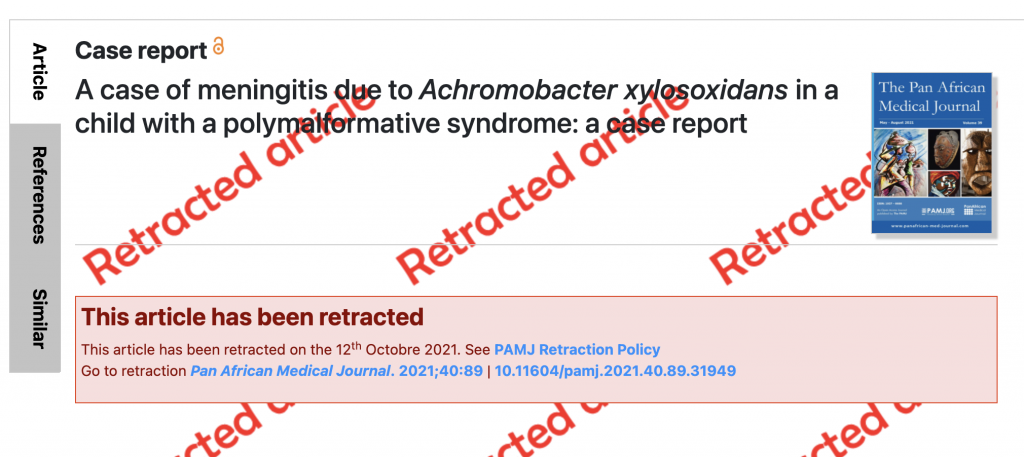
A group of neurosurgery researchers in Tunisia have lost a 2021 case study on childhood meningitis after the editors discovered evidence of plagiarism and image manipulation.
The article, “A case of meningitis due to Achromobacter xylosoxidans in a child with a polymalformative syndrome: a case report,” appeared in the Pan African Medical Journal and was written by a team lead by Mehdi Borni, of the Department of Neurosurgery at University Hospital Center Habib Bourguiba, in Sfax.
According to the notice:
It was brought to our attention that the article “A case of meningitis due to Achromobacter xylosoxidans in a child with a polymalformative syndrome: a case report” by Mehdi Borni, Mohammed Znazen, Fatma Chaker Borni, Mohamed Zaher Boudawara published in the Pan African Medical Journal [1] contains evidence of image theft and manipulation.
Our internal investigation concluded that this article has clear evidence of image theft, image manipulation and plagiarism.
First, figure 3 Panel A is similar to figure 1 in the article “Pulmonary Infection Caused by Achromobacter xylosoxidans in a Patient with Carcinoma of Epiglottis: A Rare Case” [2]. It appears that a portion of Figure 1 in the above-mentioned article was copied, and manipulated.
Secondly, figure 3 Panel B is similar to Figure 4 in the article “Nosocomial Achromobacter xylosoxidans Infection Presenting as a Cavitary Lung Lesion in a Lung Cancer Patient” [3]. The image was reused after a slight color modification.
Our investigation additionally uncovered other expression of concerns of image manipulation and theft in articles published by author Mehdi Borni [4,5].
The authors could not provide a reasonable explanation for our findings and do not agree with the retraction. The PAMJ regrets that these grave violations were not identified before publication and sincerely apologizes to the scientific community.
(If you want to see how journals should watermark retracted papers, PAMJ sets the standard.)
The references in the notice refer to two other papers by Borni that have been flagged on PubPeer over concerns about falsified data and plagiarism. One post on the site involved a 2019 article in World Neurosurgery titled “Ruptured Central Nervous System Dermoid Cyst of the Suprasellar Region Manifesting as Unusual Epileptic Seizure: A Case Report.”
That article received the following correction in August:
The authors regret that Figure 3 (on pages 1 and 4 of published manuscript) was incorrectly submitted and published. The correct figure has therefore been provided along with this new figure legend and should appear as follows: Figure 3 – “Microscopic photograph of the specimen showing keratinous material containing hair follicles (HEX100)”. The authors would like to apologize for any inconvenience caused.
Someone purporting to be Borni posted in response:
There was a mistake in submitting the manuscript The right image was already inserted instead of the wrong one
A second post on PubPeer, by “Dolichopus Shelfordi,” highlighted issues with “An isolated conus medullaris cystic lymphangioma: Uncommon location of a rare pathology revealed by an acute conus medullaris syndrome,” which appeared in Interdisciplinary Neurosurgery earlier this year. According to “Shelfordi”:
This article by Mehdi Borni et al. contains an image that was taken from another previously published article, modified and published as an original image from the patient presented as case report.
Figure 3 of this article is a modified portion of the Figure 4 of another article published in 2015 in Acta Radiologica Open: Romeo V, Maurea S, Mainenti PP, Camera L, Aprea G, Cozzolino I, Salvatore M. Correlative imaging of cystic lymphangiomas: ultrasound, CT and MRI comparison. Acta Radiol Open. 2015;4(5):2047981614564911. doi: 10.1177/2047981614564911.
These authors copied a portion of Figure 4 from the above-mentioned article (by Romeo et al.) published earlier in 2015 in Acta Radiologica Open, slightly modified the color, and inserted it in their manuscript that was submitted and then published in Interdisciplinary Neurosurgery in 2021 (6 years later).
Borni told us he disagreed with the latest retraction, which he blamed on a secretarial error:
I have sent many emails to the editor-in-chief to explain that there was a mistake made by our medical secretary when uploading images.
The images uploaded were modified and were not meant to be put in the manuscript but just for educational purposes.
I Have even send to them the right image with a big apologize for the mistake
For this reason I disagreed with the journal’s decision
Borni added that he was not blaming the secretary — for whom he declined to share contact information:
I am not accusing her. She knows about that and agree it was juste [sic] a mistake
Like Retraction Watch? You can make a one-time tax-deductible contribution by PayPal or by Square, or a monthly tax-deductible donation by Paypal to support our work, follow us on Twitter, like us on Facebook, add us to your RSS reader, or subscribe to our daily digest. If you find a retraction that’s not in our database, you can let us know here. For comments or feedback, email us at [email protected].
Ah! RW is back. This is good news.